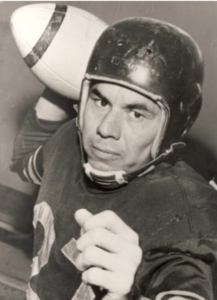Born August 7, 1919 – Died January 12, 1974
PLAYING CAREER:
WINNIPEG BLUE BOMBERS .1950 – 1954
AWARDS AND HONOURS
ALL-WESTERN QUARTERBACK 1950, 1952
JEFF NICKLIN MEMORIAL TROPHY 1952
GREY CUP PARTICIPATION 1950, 1953
He is also enshrined in the American Indian Athletic Hall of Fame in 1977, and Oklahoma Sports Hall of Fame in 2002, the Manitoba Sports Hall of Fame and Museum in 2004.
Jacobs was a versatile offensive star who alternated between the quarterback and halfback positions Jacobs was born in Holdenville, Oklahoma and played high school football at Muskogee High School. He was popularly known as “Indian Jack” because of his ethnic background, as a Creek Indian, at a time when the use of such terminology was not seen as offensive.
Jacobs played college football at the University of Oklahoma. He proved his worth as and versatility early on as averaged 47.84 yards per kick in 1940 (which remains an OU record) along with a with a career average of 42.10. Among other records he holds at OU, he accumulated the most offense yardage in 1940/1941 (junior & senior years). Even on the defensive side of the ball, he excelled and is currently tied with seven other players
for the record number of interceptions in a game (3) (1941 OU v. Marquette).
Prior to his arrival in the CFL, Jacobs was drawn to the NFL after being drafted in the second round of the 1942 NFL Draft. He played quarterback, defensive back, halfback and punter with the Cleveland Rams (1942–1945), the Washington Redskins (1946) and the Green Bay Packers (1947–1949). He led the league in punting in 1947.
As his NFL career was winding down, he joined the WIFU as a quarterback for the Winnipeg Blue Bombers from 1950–1954. His efforts were ultimately rewarded when he won the Jeff Nicklin Memorial Trophy in 1952.
The most notorious aspect of his career was the fact that Jacobs he is widely credited with making the forward pass an integral part of professional football. That unique talent that had rarely been seen anywhere else drew an excess capacity of fans to Blue Bombers games and was directly responsible for the city to build a larger stadium, Winnipeg Stadium (now called Canad Inns Stadium). Longtime Bomber fans call it the house that
Jack built.
Among his statistical records and milestones, Jacobs completed 709 of 1,330 passes for 11,094 yards and at that time the all-time leading passer for the WIFU, which was the forerunner for the CFL's West Division. In 1951, he became the first professional football player to throw for 3,000 yards in a season with 3,248. Also that season he was first player to throw for more than 30 touchdowns with 33. The next season Jacobs threw 34
touchdowns and totaled 2,586 passing yards. In the early years of the passing game in pro football, most quarterbacks registered more interceptions than touchdowns. Jacobs' proficiency is underlined by his 104 touchdown passes to only 53 interceptions. He led the western conference in passing from 1951-53.
In his career with the Bombers, he had a record of 46 wins, 27 losses and three ties. He was the losing quarterback in the 1950 and 1953 Grey Cup games.
Following his playing career, he remained involved with Canadian Football. In 1955, Jacobs was a scout for the Winnipeg Blue Bombers and later, was a coach for the London Lords of the Ontario Rugby Football Union (ORFU) for two seasons. He also worked as an assistant coach for the Hamilton Tiger-Cats, Montreal Alouettes and the Edmonton Eskimos.
When people refer to the CFL as primarily a pass oriented league, Jack Jacobs should correctly be credited as the quarterback who turned the league in that direction, during the course of his career.